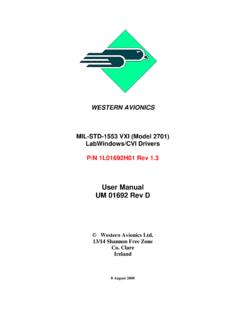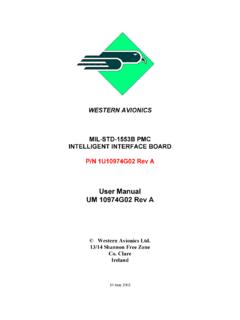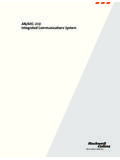Transcription of An Interpretation of MIL-STD-1553B
1 Overview1 SBS Technologies, Inc(505) 875-06001-800-SBS-1553 An Interpretation of MIL-STD-1553 BOverview0. IntroductionThis document provides an explanation of each part of MIL-STD-1553 on clause-by-clause basis. Each clause of the Standard is presented for completeness (typed in italicsfor easy reference) together with appropriate explanation or Interpretation wherevernecessary. The numbering of the clauses and figures in this document are compared tothose in MIL-STD-1553 in Table the Standard specifies a multiplex data bus for aerospace applications, it is byno means limited to these applications. MIL-STD-1553 has been widely acceptedaround the world in such unlikely places as the London underground and some brief summary of the requirements introduced by Notice 1 and Notice 2 to MIL-STD-1553 is given at the end of this ScopeThis Standard defines requirements for digital, command/response, time division multiplexingtechniques for a I MHz serial data bus and specifies the data bus and its interface example of typical multiplex data bus architecture is shown on Figure 1.
2 This Standardalso defines the concept of operation and information flow on the multiplex data bus and theelectrical and functional formats to be PurposeThe purpose of this document is to establish uniform requirements for multiplex data systemtechniques which will be used in system integration and to promote standard digital interfacesfor associated subsystems to the data bus. Even with the use of this Standard, subtledifferences may still exist between multiplex buses used in different applications due to theoptions allowed in the Standard; system designers must recognize this fact. These designerselected options must exist, so as to allow the necessary flexibility to assemble a custommultiplex system from the functionally standard above clauses are largely self-explanatory introducing the Standard and outliningits extent.
3 In highlighting the fact that different implementations of the Standard couldbe incompatible in some of the options used and the extent to which the Standard isused, system designers are reminded to ensure that they engineer coherent Definitions of TermsThe following definitions apply:2An Overview of MIL-STD-1553 BSBS Technologies, Inc(505) 875-06001-800-SBS-1553 Asynchronous operation. For the purpose of this Standard, asynchronous operation is the useof an independent clock source in each terminal for message transmission. Decoding isachieved in receiving terminals using clock information derived from the Contraction of binary digit: may be either zero or one. In information theory, a binarydigit is equal to one binary decision or the designation of one of two possible values or statesof anything used to store or convey rate.
4 The number of bits transmitted per Operation of a data bus system such that information is transmitted by the buscontroller or a remote terminal for reception by all terminals using the broadcast controller (BC). The terminal assigned the task of initiating information transfers on thedata monitor (BM). The terminal assigned the task of listening to bus traffic and extractingselected information to be used at a later Operation of a data bus system such that remote terminals receive andtransmit data only when commanded to do so by the bus bus. Whenever a data bus or bus is referred to in this document it shall imply all thehardware including screened twisted pair cables, isolation resistors, transformers, etc.
5 ,required to provide a single data path between the bus controller and all the associatedremote bus control. The operation of a data bus system in which designated terminals areoffered control of the data duplex. Operation of a data transfer system in either direction over a single line, but notin both directions on that line A single message is the transmission of a command word, status word, and datawords if they are specified. For the case of a remote terminal to remote terminal (RT to RT)transmission, the message shall include the two command words, the two status words, andthe data code. A means by which the bus controller can communicate with the multiplex busrelated hardware, in order to assist in the management of information code modulation (PCM).
6 The form of modulation in which the modulation signal issampled, quantized, and coded so that each element of information consists of different typesor number of pulses and data bus. The use of more than one data bus to provide more than one data pathbetween the subsystems, , dual redundant data bus, tri-redundant data bus, terminal (RT). All terminals not operating as the bus controller or as a bus The device or functional unit receiving data transfer service from the data Requirements3 SBS Technologies, Inc(505) 875-06001-800-SBS-1553 Terminal. The electronic module necessary to interface the data bus with the subsystem andthe subsystem with the data bus. Terminals may exist as separate line replaceable units(LRU's) or be contained within the elements of the division multiplexing (TDM).
7 The transmission of information from several signalchannels through one communication system with different channel samples staggered in timeto form a composite pulse In this document a word is a sequence of 16 bits plus a synchronization signal (sync)(three bit times) and one bit of terms. Although the above definitions include some generally acceptedterms, definitions of word size, message content, and data bus system terminology arespecific to this Requirements4. Test and Operating RequirementsAll specified requirements shall be valid over the environmental conditions in which themultiplex data bus system shall be required to clause is included to specify that the environmental conditions in which the bus isto operate are determined by the vehicle in which it is placed.
8 The environmental limitsof operation will be largely determined by the terminal components and their Data Bus OperationThe multiplex data bus system in its most elementary configuration shall be as shown onFigure 1. The data bus shall function asynchronously in a command/response mode, andtransmission shall occur in a half-duplex manner. Sole control of information transmission onthe bus shall reside with the bus controller, which shall initiate all transmissions. Theinformation flow on the data bus shall be comprised of messages which are, in turn, formedby three types of words (command, data, and status) as defined in clauses Data FormDigital data may be transmitted in any desired form, provided that the chosen form shall becompatible with the message and word formats defined in this Standard.
9 Any unused bitpositions in a word shall be transmitted as logic Bit PriorityThe most significant bit shall be transmitted first with the less significant bits following indescending order of value in the data word. The number of bits required to define a quantityshall be consistent with the resolution or accuracy required. In the event that multipleprecision quantities (information accuracy or resolution requiring more than 16 bits) aretransmitted, the most significant bits shall be transmitted first, followed by the word(s)containing the lesser significant bits in numerically descending order. Bit packing of multiplequantities in a single data word is Overview of MIL-STD-1553 BSBS Technologies, Inc(505) 875-06001-800-SBS-1553 Single bit data and other parameters which are characterized by bit patterns of fewerthan 16 bits will not fill the 16 bits of data allowed in data word format.
10 Twoapproaches can be adopted to use all the bits in a word:1. Packing multiple parameters in a word2. Filling in zeros for all unused bitsIn the first approach the encoding and decoding complexity must be considered, whilein the second approach the inefficiency of sending as little as one bit/word must Methods8. ModulationThe signal shall be transferred over the data bus in serial digital pulse code modulation modulation was chosen in view of its advantages over carrier modulationtechniques which need a greater bandwidth of transmitting media and more complexterminal Data CodeThe data code shall be Manchester 1I bi-phase level. A logic one shall be transmitted as abipolar coded signal 110 ( , a positive pulse followed by a negative pulse).






